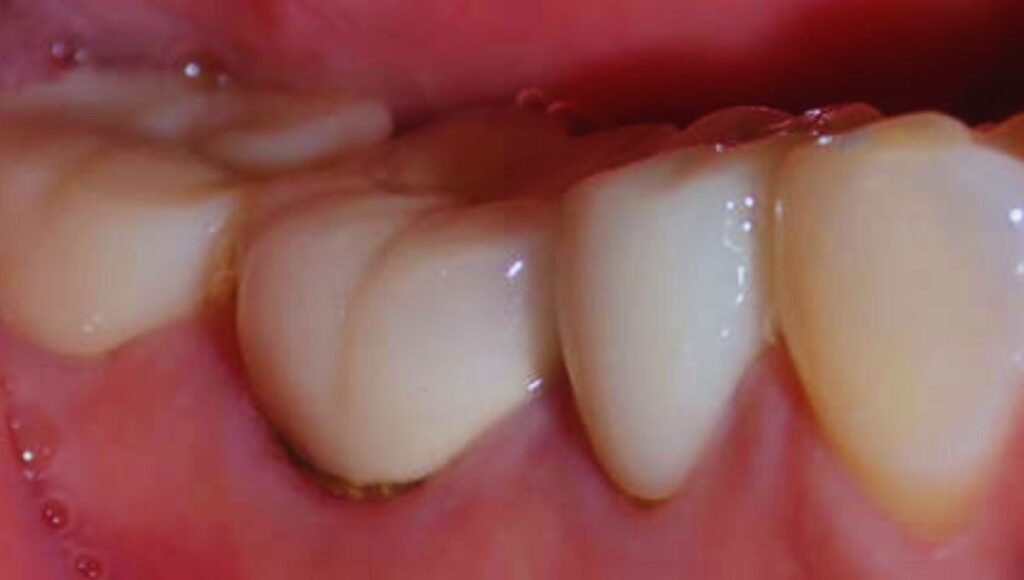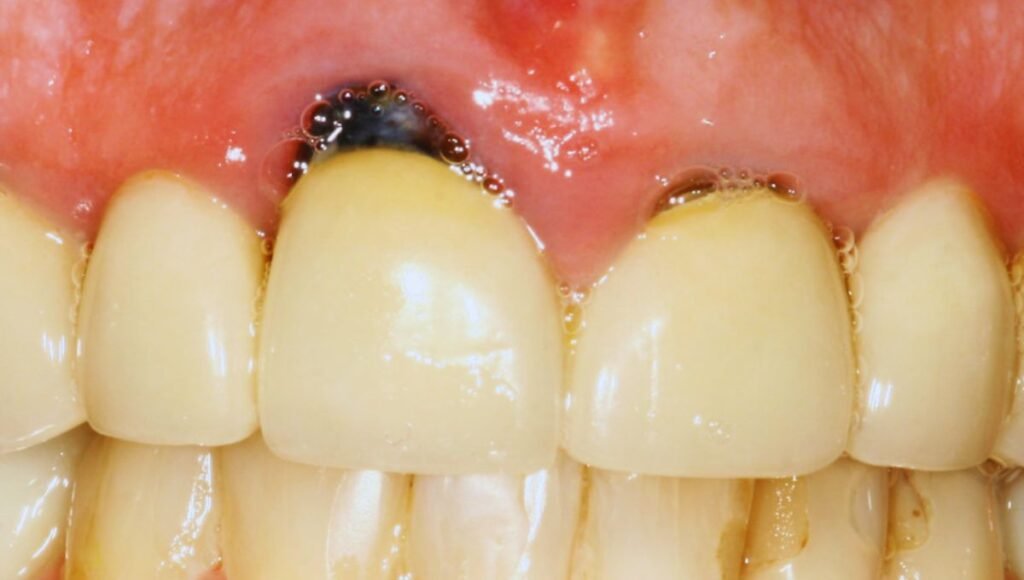Why Is My Tooth Black Under My Crown?
Have you ever noticed a black discoloration beneath your dental crown and wondered what’s going on? This change can stem from a variety of issues, including material wear, underlying decay, or perhaps a breach in the crown itself, allowing bacteria to infiltrate. It’s critical to address these signs promptly as they might signal serious dental health concerns.
Understanding the root cause is essential, and knowing the specific factors at play can help in choosing the right course of action to rectify the problem. But what exactly happens when these elements combine, and how can you take action to prevent further damage? Let’s explore.
Causes of Black Discoloration

Several factors can lead to the black discoloration of a tooth under a crown, including material degradation, bacterial leakage, or underlying decay. You need to understand that the materials used for your crown, such as porcelain or ceramic, can degrade over time. This degradation can expose the underlying metal base, which might oxidize and cause a darkened appearance at the gum line.
Moreover, if you’ve had a root canal on the tooth in question, the treatment itself might contribute to discoloration. Root canal therapy involves removing the infected or inflamed pulp, and while it’s a life-saving procedure, the tooth can sometimes darken after treatment due to residual pulp tissue or inadequate sealing materials. Ensuring that your dental professional uses high-quality materials and techniques is vital in preventing this issue.
Your smoking habits can also play a significant role. Smoking not only affects your overall oral health but can particularly compromise the integrity of a crowned tooth. The nicotine and tar in tobacco can cause significant staining, which might seep through the margins of the crown if not perfectly sealed, resulting in a blackened appearance beneath the crown.
It’s essential to address these factors proactively to maintain both the aesthetics and health of your dental crowns.
Impact of Dental Decay
While material degradation and external factors contribute to discoloration, it’s also important to consider how underlying dental decay affects a tooth beneath a crown. Dental decay, or caries, starts in the enamel and, if not treated, progresses deeper into the dentin and potentially the pulp, leading to more severe complications. This decay progression compromises the structural integrity of the tooth, impacting both the aesthetic and functional aspects of your tooth restoration.
You mightn’t immediately notice decay under a crown because the crown itself conceals early signs. However, the microbial invasion that causes decay doesn’t stop at the sight of a crown; it continues unless addressed. This ongoing decay can create a darkened appearance as the tooth structure beneath the crown deteriorates. It’s crucial to recognize that a crown doesn’t make the tooth impervious to decay; instead, it requires diligent oral hygiene and regular dental check-ups.
The integrity of your tooth restoration depends significantly on the management of any decay. Effective decay management includes timely intervention, appropriate treatment options, and continuous monitoring to ensure the longevity and functionality of both the natural tooth and the crown. This proactive approach is vital in maintaining oral health and ensuring the durability of dental restorations.
Crown Leakage Issues
Crown leakage, often resulting from inadequate seals, exposes your underlying tooth to bacterial infiltration and decay. This leakage happens when the margin, where your crown meets the tooth, isn’t perfectly sealed. Tiny gaps allow bacteria and debris to enter under the crown, leading to potential issues like infection or further decay which can cause discoloration of the tooth beneath.
To combat this, consistent crown maintenance is essential. Regular dental check-ups allow for early detection and management of any leakage. Dentists can assess the integrity of the crown and the health of the tooth underneath, ensuring that any gaps are sealed before significant damage occurs.
Furthermore, good oral hygiene plays a critical role in discoloration prevention. Brushing twice a day, flossing daily, and using an antibacterial mouthwash can help prevent the buildup of plaque and bacteria around the crown edges.
Avoiding foods and drinks known to stain teeth, such as coffee, tea, and red wine, also helps maintain the color and condition of both your natural teeth and crowns.
Effects of Metal Components
Metal components in dental crowns can lead to various complications, including allergic reactions and gum discoloration. When you choose a crown, the material selection is essential for avoiding metal toxicity.
Some metals used in crowns, particularly certain alloys, may release ions that can infiltrate the surrounding tissue, resulting in a black appearance under the crown. This discoloration isn’t just cosmetic; it could be indicative of deeper chemical reactions occurring between the crown material and your body.
The type of metal alloy used in your crown matters significantly. High noble alloys, typically consisting of gold, platinum, and palladium, are generally biocompatible and less likely to cause adverse reactions. However, crowns containing base metals like nickel or chromium may pose a higher risk of metal toxicity due to their potential to corrode and leach into your gum tissue. This process not only affects the crown’s integrity but also your oral health.
To lessen these risks, it’s important to discuss with your dentist the composition of the crown material before proceeding. Opting for a crown fabricated from high-quality, biocompatible materials can minimize the potential for metal toxicity and guarantee the longevity and health of your dental restoration.
Signs of Underlying Problems

If you notice discoloration on a tooth under a crown, it’s important to evaluate the causes and potential health implications.
This change in color can indicate underlying issues such as decay or infection, which require prompt professional assessment.
Understanding these signs helps guarantee timely intervention and prevents further complications.
Discoloration Causes
Several factors can lead to discoloration under a dental crown, indicating potential underlying dental issues that necessitate immediate attention. One primary concern is the possibility of a root canal problem. If your tooth’s nerve or pulp becomes infected or inflamed, the resulting decay and bacterial growth can alter the color of the tooth structure concealed by the crown. This discoloration often shows as a darkening shade, which might initially appear gray and progress to black.
Another critical factor to take into account is enamel damage. The enamel, your tooth’s protective outer layer, can be compromised by physical trauma or erosion. This damage doesn’t simply impact the tooth’s surface; it can extend deeper, affecting the dentin—the layer beneath the enamel. When dentin is exposed due to enamel loss, it’s more vulnerable to decay and discoloration, which can be worsened by the sealed environment under a crown.
It’s crucial to address these issues promptly. Neglecting such signs can lead to severe complications, impacting not only the aesthetics of your smile but also your overall dental health.
If you observe any changes in the color of the tooth under a crown, consult your dentist immediately to evaluate and rectify the situation effectively.
Health Implications
Blackened teeth under crowns can signal serious underlying dental issues that require professional evaluation and treatment. If you’re noticing your tooth has turned black beneath a crown, it’s vital to understand that this discoloration could be an indicator of more severe problems. Poor dental hygiene often leads to such issues, as inadequate cleaning can allow bacteria to accumulate and attack the tooth structure beneath the crown.
A blackened tooth under a crown might point to these important conditions:
- Infection: The dark color can be a sign of infection either in the gum around the crown or in the tooth’s nerve and pulp. Such infections might necessitate a root canal or further surgical interventions.
- Decay: Tooth decay under the crown can cause discoloration as the structure of the tooth breaks down. This decay can compromise the integrity of both the natural tooth and the crown restoration.
- Leakage: If the crown doesn’t fit snugly, bacteria and debris can enter under it, leading to decay and discoloration. This situation often requires the replacement of the crown to prevent further damage.
You should consult your dentist immediately to address these issues, ensuring that appropriate measures are taken to restore your dental health and prevent future complications.
Treatment and Prevention Options
You should consult a dental professional to explore treatment options for a tooth that appears black under a crown, which may include replacing the crown or treating the underlying decay. Effective crown maintenance is essential to prevent discoloration and protect the integrity of the underlying tooth.
Regular dental check-ups allow for timely adjustments and replacements of crowns, which can prevent decay from going unnoticed and leading to further discoloration.
To prevent discoloration, adhere to rigorous oral hygiene practices. This includes brushing twice daily with fluoride toothpaste and flossing regularly. Avoiding foods and drinks that stain teeth, such as coffee, tea, and red wine, can also be beneficial. If smoking is a habit, quitting not only improves oral health but also reduces the risk of discoloration.
In cases where decay is present, your dentist might need to remove the old crown, treat the decay, and then fit a new crown. This process not only restores the aesthetic appearance but also secures the long-term health of the tooth. For severe cases, more extensive procedures, like root canal therapy or even tooth extraction, may be necessary.
Always follow your dentist’s recommendations to maintain both the health and appearance of your teeth.
Frequently Asked Questions
Can a Black Tooth Under a Crown Cause Bad Breath?
Yes, a black tooth under a crown can cause bad breath. It’s essential to maintain oral hygiene and crown maintenance to prevent decay and infection, which contribute to unpleasant odors.
Is a Blackened Tooth Under a Crown an Emergency?
A blackened tooth under a crown isn’t always an emergency but requires prompt treatment to prevent further issues. Maintaining rigorous oral hygiene can help prevent tooth discoloration and safeguard your dental health.
How Quickly Should I See a Dentist for a Black Tooth?
You should see a dentist immediately for a black tooth to explore treatment options. The discoloration can stem from various causes, and prompt professional assessment is essential to prevent further complications.
Will Insurance Cover the Treatment for a Black Tooth Under a Crown?
Insurance coverage for treatment of a black tooth under a crown varies. You’ll need to verify with your insurer what costs are covered and explore your options for managing this dental issue.
Can a Black Tooth Under a Crown Affect Overall Health?
Yes, a black tooth under a crown can impact your oral health and dental hygiene, potentially leading to more serious health issues if bacteria spread. It’s important to consult your dentist promptly.
Conclusion
If you notice black discoloration under your crown, it’s vital to consult your dentist immediately. This could indicate decay, bacterial infiltration, or material failure.
Your dentist can evaluate the crown’s integrity and the underlying tooth health, possibly suggesting a crown replacement or additional treatment to address any decay or infection.
Maintaining strict oral hygiene and regular dental check-ups are necessary to prevent such issues and guarantee the longevity of your dental work.